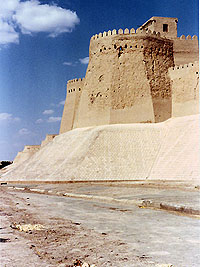 |
|
Uzbekistan - Milestones of History |
||||
|
At that time great scholars lived in Samarkand, where an scientific thought. After the tragic death of Ulughbek in 1449, both Khorasan and Maverannakhr broke up into sovereign territories. Maverannakhr was now to be ruled by the counselor of Temur rulers, Sheikh Ubaydullah Khoja Akhror. While Samarkand was taken over by both economic and cultural depression, Herat at the time saw a comparatively higher level of development. It was due significantly to the enormous work by the chief minister at Sultan Husseyn's court - Alisher Navoi, the poet and scholar. He patronized the people of art and science, administered the construction of madrasah, public buildings, canals, and bridges. In 1499 the nomadic tribes from north - the Kipchak steppes -led by Shaybanikhan invaded Maverannakhr thus putting to an end the rule of the Temur dynasty in Central Asia. The nomadic tribes that came over as a result of the invasion gradually assimilated with the local population of the region. Furthermore, Bukhara took over the status of Samarkand as an economic and cultural center, and the rule of newcomers was to be referred to as the Bukhara khanate. In the early 18th century, the Ferghana Valley separated from the khanate. Thereafter, another sovereign state - the Kokand khanate, was founded in the.southeast of the region. In 1505, armies led by Sbaybanikhon captured Khorezm, but in 1512 the rule was taken over by another dynasty, which did not join hands with the former. From that time on, the Khiva khanate was founded with its capital located either in towns of Vazir, Old Urgench, or Khiva. In the early 19th century, the Kokand khanate became one of the largest of its time. Due to the creation of the sole centralized state in Ferghana Valley, farming, commerce, and urban life as a whole saw their height. Also, handicrafts, pottery, and, especially, weaving prospered in the khanate. The khanate was famous for its cotton and silk materials. The city of Kokand turned into a center oh production of writing paper. By the middle of the 19th century, the territory of Central Asia considered to be an important economic region, which was the reason for tsarist Russia to map the all-out invasion of the khanates in the region. In this regard, at first Russia paid a significant attention to capturing vitally strategic targets of the Kokand khanate. Despite fierce and brave opposition on the part of the local population, in 1853 Russian troops captured the fortress of Okmachit, the so-called gates leading to Uzbek khanates. In 1860 the fortresses of Tukmak and Pishpak, in 1864 - Avliyoota, Turkiston, and Chimkent, and in 1865 - Tashkent, were captured. Later on, Tashkent has been made a capital of then newly established Turkestan oblast (province, region), and further in 1867 - the center of the Turkestan General Governance. In 1866 Russian troops moved further deep into the territory of the Central Asia towards the premises of the Bukhara khanate. The tsarist Russian army invaded Jizzakh, Uratepa, and Yangikurgon. Following the fierce battles that took place in 1868 at Zirabulok and Chuponota, the troops of the khanate were totally crashed leading to the capture of Samarkand, the once prosperous center of Amir Temur's vast empire and one of the ancient capitals of Central Asia. As an outcome of the unfairly signed agreement between the parties, the Bukhara khanate paid huge reparations to tsarist Russia and turned into its protectorate. Russian military campaign of 1873 to Khiva has also ended with enormous success for the Russian army. As a result, the Khiva khanate has lost its sovereignty, as well. In the captured area of the khanate, Russians are said to have established the Amudarya unit of the local rule. In 1875 and 1876 the Russian government took advantage of the local revolt in the Kokand khanate. With a trick of assisting the then ruler of the khanate - Khudoyarkhan - in crashing the revolt, it sent its troops to the khanate. Thus, following such tricky campaign, the khanate had totally lost its sovereignty to Russia, and the Ferghana province, that joined the Turkestan General Governance, has been established in the area. Henceforth, the territory of the contemporary Uzbekistan had been turned into the colony of tsarist Russia. Colonial administrative apparatus has been well put in place in the region. Issues of local agriculture and proprietorship are said to have been "tackled" first. |


